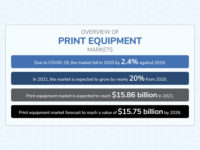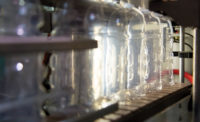Based on a late March 2020 study, when the North American impact of COVID-19 was beginning to make itself known, L.E.K. Consulting, a global consulting firm, predicted that the packaging industry’s future was bright and that the pandemic would have a major — positive — impact.
According to the analysts, “in certain categories such as e-commerce, packaging providers are scaling
According to the analysts, “in certain categories such as e-commerce, packaging providers are scaling [increasing] production and benefitting from pull-through demand.” production and benefitting from pull-through demand.”The industries, according to the analysts, that will be in the forefront with the most significant demand for packaging products and materials are the following:
Healthcare
- E-Commerce
- Food and Beverage
- Personal Care Products
For the most part, the predictions have come true. These are the industry sectors that grew the most at the start of the pandemic. However, the study concludes with the following:
“While challenging times are certainly ahead for the packaging industry, pockets of near-term velocity are present in the market and addressable to proactive manufacturers.”
In other words, the good times may not last forever.
One of the most significant impacts on the packaging industry and its distributors are supply chain disruptions. Further, what we’re likely to find is that while supply chain disruptions are certainly nothing new to many industry sectors, disruptions caused by COVID may be far more sweeping and have a far greater impact than previous disruptions.
Typical Distribution Patterns
Usually supply chain disruptions are limited by geography, only affect specific industries, or there is some “Plan B” in place that quickly reduces, if not eliminates, any pain and suffering.
For instance, when the uncontrolled brush fires were ablaze in Australia last year, as devastating as they were, supply chain disruptions primarily impacted Australia and some nearby countries. However, if shortages occurred, such as food items, they were addressed by importing from nearby countries.
The fires in Australia followed typical patterns. They were geographically isolated incidents, and when problems arose, Plan Bs were in place to address supply chain challenges.
Similarly, here in the U.S. when Hurricane Katrina landed in New Orleans, it resulted in more than 8 million gallons of oil spilling into the ground and waterways in Louisiana and Alabama. Along with all the environmental damage, this resulted in shortages of oil and gas in the area and other parts of the country.
However, then-President George W. Bush released oil from the nation’s Strategic Petroleum Reserve, allowing ample supplies of fuel to be delivered — meeting short-term demand and minimizing the impact on the supply chain.
Like the Australian brush fires, the hurricane affected just one area of the U.S. While its impact did affect other states, Plan Bs went into place quickly to meet the area’s — and the country’s — supply chain needs.
However, as we shall see with COVID, supply chain patterns have come into play that are anything but typical.
COVID at the Helm
COVID has finally proven that the world is interconnected. What happens in one part of the world can impact what happens in other areas of the world.
For instance, when it comes to the transporting of masks and PPE (personal protective equipment) from China, if China couldn’t meet the worldwide demand or needed the products for its own country, then the rest of the world had no option but to wait. While other countries soon started producing their own materials, they were limited because no Plan B was in place to tackle the challenge.
Another way COVID is different from past supply chain disruptions is its scope. Manufacturers around the world have all been impacted.
When certain raw materials or components are no longer available, it slows — if not eliminates — the production of many other products made by manufacturers globally. And even when supplies once again begin to flow, it’s often stop-and-go.
This requires manufacturers to turn to mapping strategies to have a better idea of when they can expect certain materials, if those materials might be delayed and what is causing the delay. 1
COVID is also atypical in that the duration of most other supply chain disruptions is finite. For example, a disruption occurs because of a major storm. However, in a relatively short time, things return to normal — as do supply chains.
With COVID, we’ve had spikes and lulls worldwide, but it is still with us. It took almost two years for the 1918 influenza pandemic (aka, the Spanish Flu) to disappear. This may be true with COVID, or it may last even longer.
Moving Forward
We can, and have, learned a lot from this pandemic, and hopefully, it will be the only one most of us experience in our lifetimes. But something almost as serious can happen again.
As we make our way through the current situation and the current “new normal,” manufacturers and distributors must start thinking about what we have learned and what steps we should take if such a situation occurred again. Among them would likely be the following:
Taking care of our employees. Remote working is no longer new. We know what steps must be taken to make it work and work quickly. This means much of the confusion and disruption that occurred earlier in the year when remote working went into place can be avoided.
Staying close to customers. Some customers were caught off guard, needing many supplies that were invariably always in stock. This created much frustration, causing many to jump ship and look for new suppliers. Keeping customers apprised as to what steps are being taken to deliver those supplies can minimize the frustration and help retain them.
Join membership organizations. This applies to distributors. For example, many independent distributors in the professional cleaning industry soon ran out of disinfectants and paper products at the beginning of the pandemic. However, those who belonged to membership organizations were often able to tap into other members’ supplies. Further, membership organizations, whether it is cleaning or packaging, often have business relationships with manufacturers, allowing them to be first in line for products in short supply.
Cybertechnology issues. Most companies have an IT setup that protects the company computer and cloud systems from hackers while workers are in the office. But this security may not apply when workers are working from home and logging into company computers. IT strategies must be expanded to protect from technology threats, whether workers are working in the office or remotely.
Finally, being flexible is crucial — now during COVID and in the future should another crisis arise. Being nimble allows us to move quickly, which can help protect our businesses, our people and our bottom line.
1. Mapping is identifying all the vendors a manufacturer, for instance, depends on for materials, and then further identifying all the vendors down the chain that that vendor depends on for goods and materials.




